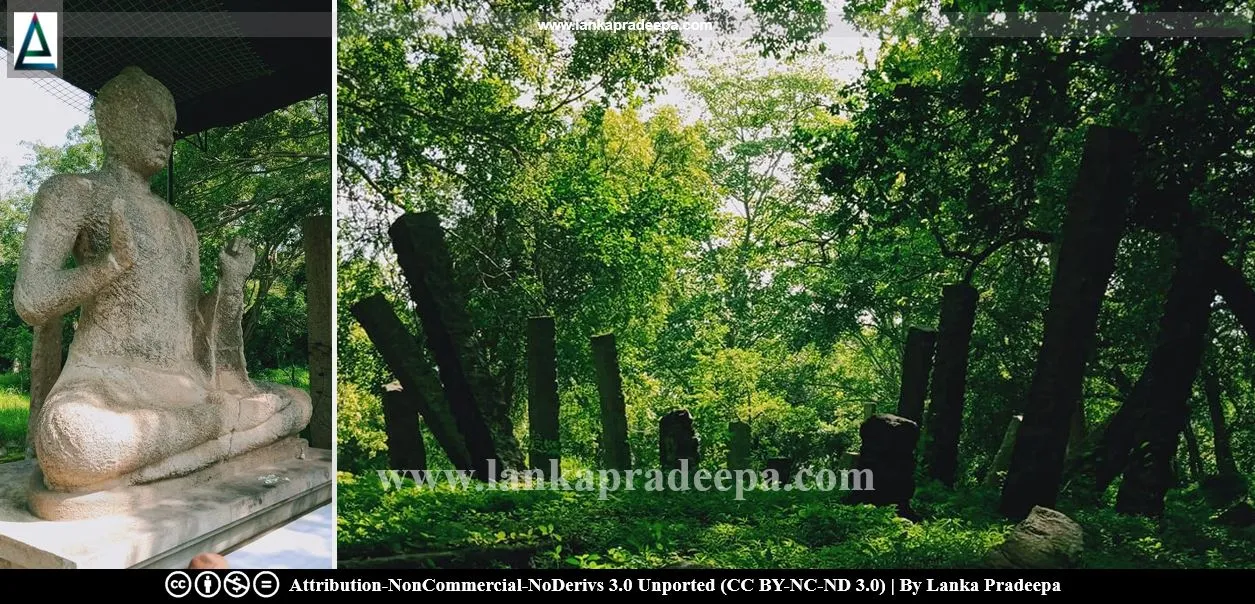
Asokaramaya, also referred to as Pankuliya Archaeological Site (Sinhala: පන්කුලිය අසෝකාරාමය), is a ruined Buddhist monastery situated in Anuradhapura District, Sri Lanka. The site is famous for its seated Buddha statue popularly known as Pankuliya Buddha.
History
According to local tradition, this is probably the Asokaramaya monastery established by Prince Saliya, the son of King Dutugemunu (161-137 B.C.), after his low-caste wife Ashokamala (Sandaruwan et al., 2017). According to Mahavamsa, King Mahasen (276-303 A.D.) built a monastery named Uttara Mehenawara for Buddhist nuns in about 276 A.D. and some identify the present Pankuliya as part of that monastery built by Mahasen (Sandaruwan et al., 2017). A pillar inscription by King Dappula IV (924-935 A.D.), that was discovered from Pankuliya contains details about an immunity grant made in respect of some land assigned to a Buddhist Nunnery named Kalahas-mehenawara founded by a high dignitary named Pirivahanu (Warden) Koda Kasbalna of Dhannavala (Ranawella, 2004). However, no information is known from any other source about this Nunnery yet (Ranawella, 2004).
Another inscription of Pallava-grantha characters has been found on the steps at the entrance to the image house (Wikramagamage, 1990). It indicates that the Pankuliya image house and the Buddha image may belong to the latter half of the 7th century A.D. or 8th century A.D. (Jayasuriya, 2016; Wikramagamage, 1990; Wikramagamage, 2004).
Another inscription of Pallava-grantha characters has been found on the steps at the entrance to the image house (Wikramagamage, 1990). It indicates that the Pankuliya image house and the Buddha image may belong to the latter half of the 7th century A.D. or 8th century A.D. (Jayasuriya, 2016; Wikramagamage, 1990; Wikramagamage, 2004).
The monastery
Asokaramaya is a monastery of the Pabbatharama Vihara (rock
monasteries or mountain temples) type (Jayasuriya, 2016; Wikramagamage,
2004). Prachina Tissa Pabbata Viharaya, Vijayarama, Puliyankulama Purvarama, and
Toluvila are several other monasteries that have features similar to Asokaramaya monastery. The site was first investigated by H.C.P. Bell in 1892 (Sandaruwan et al., 2017). Ruins of the image house with the Pankuliya Buddha and several other buildings are found in the site.
Pankuliya Buddha statue

The statue differs from the usual Samadhi Buddha statues in the country (Jayasuriya, 2016). The statue is 7 feet 6 inches tall and 6 feet wide. It is sitting in the Virasana posture, showing an attitude of preaching/teaching Dhamma. Both hands of the statue are raised. The right hand depicts Vitarka Mudra (argumentation gesture) while the left hand depicts the Kataka Mudra [(ring hand) Wikramagamage, 2004]. The statue popularly called "Devana Samadhi" at Abayagiriya monastery possibly had the same Mudra of the Pankuliya Buddha, of which hands are now destroyed (Jayasuriya, 2016). A similar gesture can be seen on the small bronze statue known as Badulla Preaching Buddha which is now in Colombo National Museum (Jayasuriya, 2016). On the crown of the head of the Pankuliya Buddha is found the Usnisha which is larger than the Usnishas found in the Buddha images of the 6th century A.D. (Wikramagamage, 1990). The perforation on the top of the Usnisha may have been used to attach a Siraspatha [(the flame of knowledge) Wikramagamage, 2004]. The craftsmanship of the statue is said to be equal to the Samadhi Statue and Toluvila Statue (Jayasuriya, 2016).
Due to exposure to the environment for a long time, the face and fingers of the Pankuliya statue have been badly washed off. There are several opinions regarding the date of the statue. S. Paranavitana believes that this statue belongs to the 6th century A.D. (Sandaruwan et al., 2017; Wikramagamage, 1990). According to D.T. Devendra, this is a work of the 4th century A.D. (Sandaruwan et al., 2017). C. Wikramagamage in the opinion that this is a work of the 8th century A.D. while A. Seneviratna says it belongs to the 9-10th century A.D. (Sandaruwan et al., 2017; Wikramagamage, 2004).


 .
.
.
.
References
1) Jayasuriya, E., 2016. A guide to the Cultural Triangle of Sri Lanka. Central Cultural Fund. ISBN: 978-955-613-312-7. pp.56-57.
2) Ranawella, G.S., 2004. Inscription of Ceylon. Volume V, Part II. Department of Archaeology. ISBN: 955-9159-30-5. pp.15-17.
3) Sandaruwan, W.M., Jayasooriya, T.H.G.A.K. and Pathirana, R.G.S.S., 2017. මහායාන භික්ෂුණි ආරාමයක් ලෙස සැළකෙන පන්කුලිය හෙවත් අශෝකාරාමයේ පුරාවිද්යාත්මක වටිනාකම පිළිබඳ විමසුමක් (In Sinhala). pp.223-224.
4) Wikramagamage, C., 1990. Section II: 500-100 A.D. Archaeological Department Centenary (1890-1990): Commemorative Series: Vol. IV: Sculpture. pp.50-51.
5) Wikramagamage, C., 2004. Heritage of Rajarata: Major natural, cultural, and historic sites. Colombo. Central Bank of Sri Lanka. p.112.
2) Ranawella, G.S., 2004. Inscription of Ceylon. Volume V, Part II. Department of Archaeology. ISBN: 955-9159-30-5. pp.15-17.
3) Sandaruwan, W.M., Jayasooriya, T.H.G.A.K. and Pathirana, R.G.S.S., 2017. මහායාන භික්ෂුණි ආරාමයක් ලෙස සැළකෙන පන්කුලිය හෙවත් අශෝකාරාමයේ පුරාවිද්යාත්මක වටිනාකම පිළිබඳ විමසුමක් (In Sinhala). pp.223-224.
4) Wikramagamage, C., 1990. Section II: 500-100 A.D. Archaeological Department Centenary (1890-1990): Commemorative Series: Vol. IV: Sculpture. pp.50-51.
5) Wikramagamage, C., 2004. Heritage of Rajarata: Major natural, cultural, and historic sites. Colombo. Central Bank of Sri Lanka. p.112.
Location Map
This page was last updated on 9 December 2023

